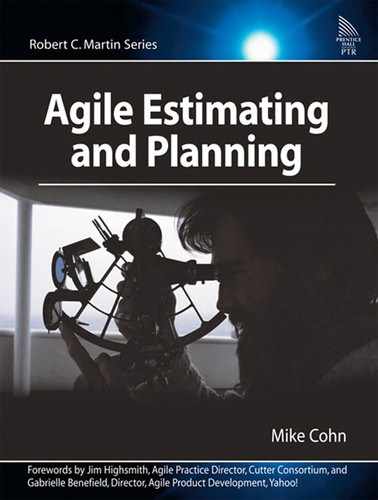Contents
Foreword by Gabrielle Benefield
Part I: The Problem and the Goal
Chapter 1: The Purpose of Planning
Planning Is by Activity Rather Than Feature
Multitasking Causes Further Delays
Features Are Not Developed by Priority
Chapter 4: Estimating Size with Story Points
Chapter 5: Estimating in Ideal Days
Ideal Time and Software Development
Ideal Days as a Measure of Size
Chapter 6: Techniques for Estimating
Introducing the SwimStats Website
Re-Estimating Partially Completed Stories
Chapter 8: Choosing between Story Points and Ideal Days
Considerations Favoring Story Points
Considerations Favoring Ideal Days
Chapter 9: Prioritizing Themes
Chapter 10: Financial Prioritization
Chapter 11: Prioritizing Desirability
Kano Model of Customer Satisfaction
Relative Weighting: Another Approach
Chapter 12: Splitting User Stories
Splitting across Data Boundaries
Splitting on Operational Boundaries
Removing Cross-Cutting Concerns
Don’t Meet Performance Constraints
Split Stories of Mixed Priority
Don’t Split a Story into Tasks
Avoid the Temptation of Related Changes
Chapter 13: Release Planning Essentials
Chapter 14: Iteration Planning
Tasks Are Not Allocated During Iteration Planning
How Iteration and Release Planning Differ
Velocity-Driven Iteration Planning
Commitment-Driven Iteration Planning
Relating Task Estimates to Story Points
Chapter 15: Selecting an Iteration Length
Factors in Selecting an Iteration Length
Chapter 16: Estimating Velocity
Chapter 17: Buffering Plans for Uncertainty
A Schedule Buffer Is Not Padding
Chapter 18: Planning the Multiple-Team Project
Establishing a Common Basis for Estimates
Adding Detail to User Stories Sooner
Incorporating Feeding Buffers into the Plan
Part V: Tracking and Communicating
Chapter 19: Monitoring the Release Plan
Chapter 20: Monitoring the Iteration Plan
Chapter 21: Communicating about Plans
Part VI: Why Agile Planning Works
Chapter 22: Why Agile Planning Works
Estimates of Size and Duration Are Separated
Plans Are Made at Different Levels
Plans Are Based on Features, Not Tasks
Small Stories Keep Work Flowing
Work in Process Is Eliminated Every Iteration
Uncertainty Is Acknowledged and Planned For
A Dozen Guidelines for Agile Estimating and Planning
Chapter 23: A Case Study: Bomb Shelter Studios
Preparing for Product Research
Iteration and Release Planning, Round 1
